One of the best methods of marketing that I’ve seen evolve in a dramatic fashion over the last year is the Daily Deal marketing concept.
Now – “daily deal” marketing is nothing new or groundbreaking. It’s a practice that has been around in marketing forever. It combines two strong forms of selling – “limited time product” with “cheap product”. Both of these practices on their own are very strong – put them together and the results can be very positive.
But one thing that is relatively new is businesses building their whole business around it.
Now I’m not sure if it was the first website to do this – but one of the initiators was woot.com.
Their business plan can be summarized with their tagline – “One Day, One Deal”. Every day, there would be a different item available for sale. They usually had limited stock so if the product ran out, everyone else was SOL. Woot also would never list a new item on the same day – they would always wait until the very next day before listing a new item.
 What Woot really did that was groundbreaking however, was its interaction with customers. Honestly, a lot of the times the items on woot were the same items you would find on the shelves at Liquidation World or a cheap electronics store. There was a lot of liquidated items and refurbished items.
What Woot really did that was groundbreaking however, was its interaction with customers. Honestly, a lot of the times the items on woot were the same items you would find on the shelves at Liquidation World or a cheap electronics store. There was a lot of liquidated items and refurbished items.
However Woot never attempted to insult the customers intelligence. They spoke to the customer on their level. They wrote witty, entertaining descriptions. They created a huge community. They created a ridiculously strong and trustworthy brand name. You had people buying items off woot that they didn’t need or even want until woot posted about it.
Hell – Woot would even promote a mysterious “Bag of Crap” where you were paying money with absolutely no idea what you would get – and these would be their highest selling days!
So – Woot was successful. As a website it evolved into sub-categories. Along with the general Woot website they opened up new websites like “Wine.woot”, “Kids.woot” and “Shirt.woot”. Wine.woot would offer wine-related products every day, Kids.woot would feature childrens products every day, and Shirt.woot would feature a different t-shirt every day.
And it’s that last one that we’re going to focus on.
Here’s something that will hopefully surprise no-one: if you do something successful, people will copy it. Yeah, big shocker right? Sometimes the websites are poor imitations (think of all the sites that try and copy Pokerlistings), while others come along and do it a lot better (ie: Reddit, Facebook). Woots t-shirt website was a huge success, and that has spawned many copycat websites with more opening every day.
And it’s bloody fascinating.

This industry is still growing at the moment, and is really still in its infancy. As more and more people catch on, more websites are cropping up. At this time there’s a few “tried and true” methods that work – but we’re still seeing all these t-shirt sites try out new things. With more competition popping up, the existing websites are then trying to “up their game”. I’m sure eventually it’ll get to the stage that any business like this gets – due to over saturation it becomes cut-throat and only minimal profit margins.
But at this point in time, it really is a business model you need to study. I wanted to write today about various marketing methods the daily t-shirt websites use, and their business model in general.
What does all this have to do with affiliate marketing?
When it comes to research, I find that affiliate marketers often limit themselves. They rely on blogs, communities and websites rather than going out and looking at actual, real-world data.
You can learn so much about marketing just by turning on the TV. If you’re heading out of the room during Superbowl commercials to get more Doritos, or you’re skipping through the commercials when you’re watching TV shows on your PVR – you’re missing out on some incredibly valuable marketing data and research. You have multimillion dollar marketing campaigns right in front of you – there is so much you can learn from that Youtube Ad before a video, or how McDonalds handles their Monopoly game.
The “daily deal” business model is on the rise right now, and there’s so many interesting marketing methods and general strategies out there that you really should be paying attention to it.
Now let’s look at these daily t-shirt websites, and how they conduct their business:
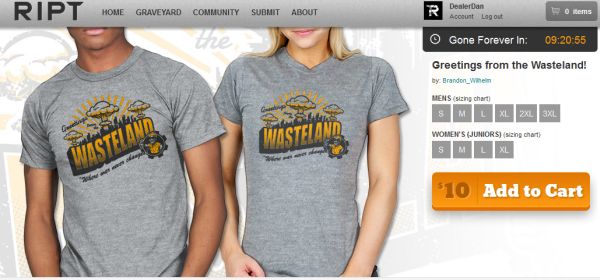
What Daily T-Shirt Websites Are There?
First things first – it’s possible you haven’t even visited a daily t-shirt website in your life. So I’m going to provide a list of the main ones – feel free to click through each one, get a “feel” for them and then come back:
https://shirt.woot.com/
https://www.teefury.com/
https://www.riptapparel.com
https://www.anotherfinetee.com/
https://www.othertees.com/
https://www.qwertee.com
https://theyetee.com/
https://shirtpunch.com/
On top of that, DayOfTheShirt.com is focused on listing ALL new designs every day, so you only need to actually visit their site, as opposed to bookmarking all the others. (And look at how they sneak the ads in there – I dig it!).
Limited Time Marketing:
I don’t really have to explain this one, do I? It’s limited time marketing – it forces a decision. People only have 24 hours (for most of the sites) to buy a t-shirt. It changes the mindset. It stops the visitor from out-thinking themselves. They know they have to make a decision quickly – and basic consumerism always sways to the “buy” mindset. Just look at Walmart on Black Friday to see that for yourselves.
What’s funny is 99% of these t-shirts are NOT limited time – you can actually buy them at RedBubble.com (albeit for a more expensive price). But the majority of the userbase is simply not aware of this.
Simplicity:
Above-the-fold is the main focus for purchasing. They have made it as simple as possible. The elements are usually the same:
- Models displaying the t-shirts
- Countdown clock showing how long you have to purchase
- Choice of Mens/Womens and size option
- Big “Buy” or “Add to Cart” CTA.
Those are the primary elements. Those are the “basics” that every site sticks with. There are numerous secondary elements to the homepage, I wrote an article that covered this topic in more detail but from an affiliate marketers perspective: Copying a Successful Affiliates Marketing Constant which you should read for more on that topic. Here are a couple of examples and you will be able to see the similarities:
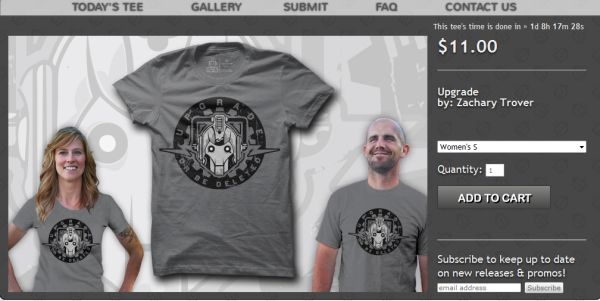
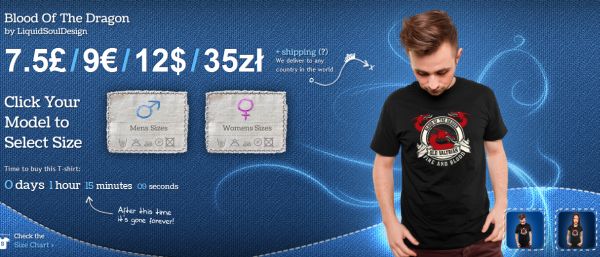
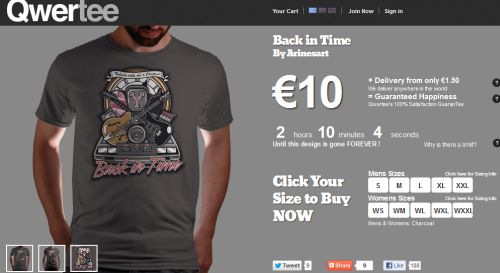
One constant I do want to mention though is the websites using actual real people to display the t-shirts. This may not seem like a big deal but it’s huge – people are still wary of purchasing clothing online because you don’t really know for sure how it will look, or how it will fit. Some designs can be relatively misleading. Using actual real people to display the product is very smart because it immediately increases the visitors comfort factor in regard to the product.
Curiousity Factor:
Usually when you are an online retailer, you only get people coming to your site when they actually want to buy what you have to offer. I mean do YOU visit Newegg on a daily basis? If I need computer parts then NewEgg is my first stop – but other than that, I forget the site actually exists the rest of the time.
With these type of sites you get an absolute ton of repeat visitors because people don’t know if they’re going to want something until they see it – so they NEED to come back each day. And getting the potential customer there is half the battle.
Demand and Supply:
One reason that these websites are so appealing to start up is because of the low overhead. Unlike other t-shirt websites that create a huge selection of t-shirts and have many of them sitting around, running themselves into the red until they sell – the daily t-shirt sites don’t have that concern.
They only produce what the demand is. They know EXACTLY how much their customers want, so they’re never running at a loss when it comes to printing costs. And by limiting the customer to a one day purchase it allows them to focus purely on batch production, which is a real money saver when it comes to printing.
Easy Business to Run:
Okay I’m not saying this is an EASY business to run – far from it. But there are some great aspects to this business that make it a lot easier to run than other business.
Half the work when selling merchandise is the design aspect. They use freelance graphic designers who submit their artwork to them – so that aspect of the site runs itself! They have practically eliminated one of the toughest jobs by having other people submitting their work to them and doing their job for them. And artists are queuing up to get listed on their site.
Their web based system for displaying their merchandise is most likely very simple and easy too. Their systems are (hopefully) practically automated – it’s a case of uploading a new graphic, adding in some text and then letting the automated system do the rest of the work, like archiving the old t-shirts, updating all the graphics all around the site, on their Facebook page etc.
Visitor Based Marketing:
One great thing about these types of sites is your customers do the marketing for you!
One regular visitor will see a Breaking Bad t-shirt or a Batman t-shirt, and tell any of his friends who are into Breaking Bad or Batman and will wear that style of t-shirt. So there’s a lot of customer referral marketing going on (yet a surprising lack of refer-a-friend programs; I would be encouraging that).
Then there’s the graphic designers – the guys making the designs that end up on t-shirts. You think they’re going to keep quiet? Of course not. They’ll be over the moon that their designs are in print. They’ll be telling anyone and everyone, introducing whole new customer bases to the sites AND introducing all their designer friends who will also submit designs, continuing the process.
Hell, you could start a site like this up with zero marketing needed. Just pay a few popular designers upfront to get the ball rolling, and you’re good to go.
Teasing the Visitors:
One thing you want customers to do is want something that they can’t have – or they have to wait for. If you need an example just look at the Nintendo Wii when that launched. It’s why companies advertise new products sometimes up to a year in advance. Their aim is to get the customer practically salivating at the thought of owning that product.
Some of these sites do that too. They offer “side art” or allow the visitor the chance to vote – designs in the sidebar that are not yet for sale and may never be for sale. Then they gauge the visitors interest in them – not a day goes by without people commenting just on the side art, and how badly they want it.
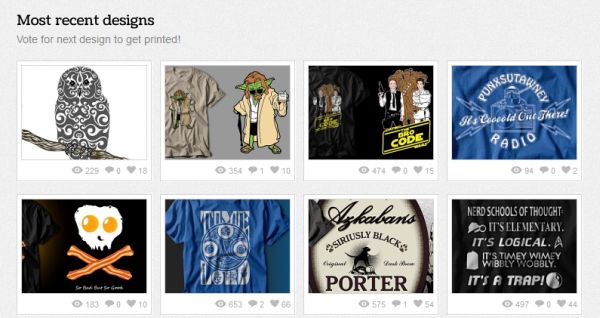
Not only are those visitors then ready to insta-buy that design – but it has them coming back every day, waiting for the design that they want. And then another design may just catch their eye.
Careful of Over-saturation:
These daily t-shirt sites cover a wide variety of t-shirts. Movies, TV, Video Games, pretty artwork – the lot.
Obviously, some t-shirts will be more popular than others. So lets say one day, they run a Breaking Bad t-shirt and the sales are 200% more than the average day. Then 2 weeks later, they run another Breaking Bad t-shirt and see the same level of sales.
A bad businessman would look at that and say “Lets run Breaking Bad t-shirts EVERY DAY”.
However the guys behind these websites are smart. They know that one of the key selling points is the rarity of the items. By flooding the market with the same concept, idea or style over and over it will just turn a lot of users off.
Many people buy t-shirts from these sites purely due to that. I’ve never went out of my way to buy a Fallout Video Game t-shirt for example. However I own 4 separate Fallout: New Vegas t-shirts all from these sites, simply because when they appear once every month or so, they really seem like a rarity.
On top of that – they don’t abuse their model. If they had a popular design they could “bring it back for one day only”. I’ve seen that happen – but only a handful of times. They realize how crucial the limited time marketing method is when it comes to selling, and never abuse that.
Squeezing Blood from a Stone:
I saved my favourite one for last.
I’m sure there’s a limited amount of earnings when it comes to these websites. Probably a slow growth with a few big spikes depending on the t-shirt offered. So what we are seeing is these websites trying ADDITIONAL marketing methods to try and squeeze more purchases out of the visitor.
A few examples:
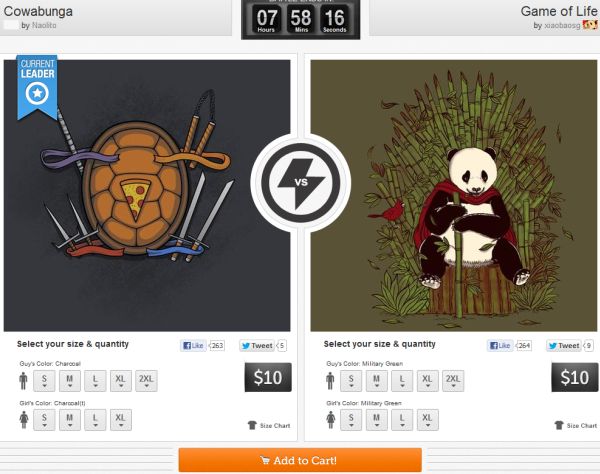
- “T-shirt battles”: As shown above. Well, the guise of a battle anyway. Rather than one design the site will sometimes offer TWO designs. And people vote on what one is best by buying it! It’s the basic “Tip Jar Question” concept which works every time.
- “Mystery Bag”: This is a common one of course – maybe once a month, or once every two months they’ll offer the chance to buy a mystery set of t-shirts. The price will be cheaper but you won’t have any idea what you get. People LOVE this crap – they LOVE the idea of a mystery. As I mentioned about woot and their bag of crap above – these can be the biggest moneymaking days for these sites.
- The Last Chance: Occasionally, these sites will give visitors a “last chance” to buy a t-shirt. After the day is up, they may have an additional 8 hours to change their mind and purchase the t-shirt. This one thankfully hasn’t been abused yet as it’s not used often – and therefore it still works. It can convert on the fence visitors. It can convert visitors who forgot to check the day before. And one more thing: visitors are going to these websites WANTING to buy something. If they go and see the daily t-shirt isn’t a design they want – well, they may look at the “Last Chance” t-shirt and think “Eh, why not”, lining the pockets of these sites just a little more.
In Conclusion:
There is an absolute wealth of knowledge available when it comes to these websites for affiliate marketers. Even if you’re not interested in purchasing any of these t-shirts, you should be studying them and the methods they use. Look at what works and what doesn’t – what changes they incorporate, what new marketing methods they utilize etc. There’s so much we can learn from them – not just in their successes, but their failures too. Because believe me – as the competition increases, these sites are going to start using many more risky marketing methods.
And with more and more affiliates these days looking to start their own business, this may be one business model you should consider. But if you do that, just remember one thing:
Do it better.

 Dealer Dan, pictured here with WWE Superstar Mick Foley, has been in internet marketing since 1996. He likes hugs, long walks on the beach, and making money while wearing his jammy jams. For more information, you can read all
Dealer Dan, pictured here with WWE Superstar Mick Foley, has been in internet marketing since 1996. He likes hugs, long walks on the beach, and making money while wearing his jammy jams. For more information, you can read all 













